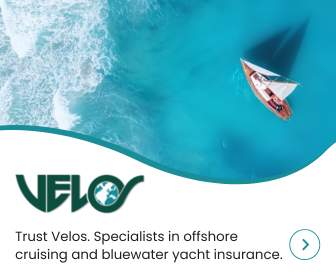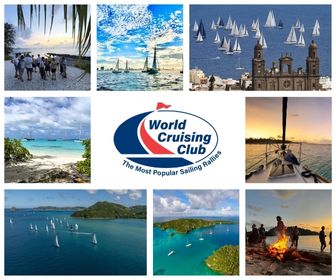Schengen Visas and VAT: Reports on Cruisers’ Understanding
Reports from long-term cruisers on how they coped with the restrictions of EU VAT and Schengen Visas. Scroll down for most recent reports.
Published 9 years ago, updated 7 years ago
Posted 9th October 2014
Canadian cruiser Con Sprenger has been cruising the Mediterranean for 8 years, and Greece for 4 of those years. In this report, he outlines his understanding of the possible options for any non-EU boats considering doing some extended cruising in and around the Mediterranean.
Schengen is an agreement between some European countries to create a borderless Schengen area and named after the town in Luxembourg it was originally signed in 1985.
EU or European Union is a politico/economic union between European member states.
Two main issues: boat and person(s) – EU and Schengen. Not all countries belonging to the EU are part of Schengen and vice versa, for instance, Switzerland is not a member of the EU but is part of Schengen, the UK is a member of the EU but not of Schengen. The EU facilitates ease of moving goods between countries, Schengen does likewise for people.
To determine who belongs to the EU or to Schengen consult the internet, there are multiple websites giving details, lists do change from time to time; for instance, Croatia became a member of the EU on July 1st, 2014, but is not a member of Schengen yet.
EU/Boat:
It is my understanding that EU regulations allow non-EU registered boats to remain in the EU for up to 18 months without being subject to VAT (European sales tax). (Editor’s Note: this only applies when the boat is neither owned or sailed by an EU resident, otherwise it can only stay for 1 month). If a boat stays continuously in the EU for more than 18 months there are serious risks of being taxed, which will be at the rate of the country the offence is committed to – rates vary from 15 to 25 per cent between EU countries.
To avoid VAT a boat must leave the EU before the end of the 18th month, the length of time required to be absent is undetermined and it is impossible to get an EU official to give a clear and precise answer.
In the Mediterranean, there are only a few countries easily accessible by boat left to re-set the EU VAT clock; Morocco, Tunisia, Montenegro, Albania, Turkey, Northern Cyprus and Israel. Libya, Algeria, Syria and Egypt are also outside the EU, but travel there might not be advisable.
With some forward planning, it is possible to avoid VAT, while at the same time exploring exciting destinations. Key is to make sure you get and save written documentation of the boat has been to these non-EU countries, such as marina receipts, fuel bills, or if the boat has been hauled out and worked on, receipts of such. (A stamp in your passport is not proof that the boat was out of the EU).
Likewise, it might be useful to save receipts of EU marinas/expenses from just prior to leaving the EU in order to establish a clear path.
Use your own judgement for the length of time to be absent – I have known boats returning within one or two days.
Schengen/person(s):
90 days in a 180 day period is the rule, the 180 days starts on the day of first entry in any of the Schengen countries. This can be 90 continuous days or 3 periods of 30 days or any combination, but no more than 90 days in 180.
This applies to all countries that have signed the Schengen agreement. Leaving for a non-Schengen country within the 180 day period and returning before the end of the 180 day period does not reset the clock.
It should be noted that similar rules apply to most non-Schengen countries, such as Turkey, Cyprus and Croatia to name a few. Depending on your passport, visa’s might be required, do you own due diligence.
In some countries, the 90 days can be extended, but we have never found clear information on which ones, where and how. In Portugal, we did manage to get a visa for an additional 30 days, but after having gone through the lengthy and costly process we’re told it was only valid for Portugal, which completely defeated the purpose since we were going to Spain.
In some cases extended visas can be obtained prior to arriving in a Schengen country, in almost all cases the process is difficult and expensive and still requires follow-up visits to immigration or police in the Schengen country.
The rules and the reality, in many cases, do not mirror each other. We met many, many cruisers who overstayed the 90 day period and were not bothered by officials, we know of some that were fined.
It is not always easy to complete proper clearing-in procedures, and in some cases it is impossible. We know of situations where Schengen immigration officials have refused to stamp passports. Likewise, with clearing out, it is not always possible to find the right officials or they might not be willing or interested in completing the documentation.
I tried to be as clear and as accurate as possible, the audience needs to understand that the above is my personal interpretation of complex legal issues and its use is at their own risk.
Con Sprenger
SY Big Sky
——————————————————————————————————————————————-
Posted 26th August 2015
The above report is accurate for the first part (RE: boats in the EU and VAT); however, it is not an entirely accurate description of the Schengen rules in the second part. This is technically the old explanation and description. The new rules took effect on 18 October 2013.
The newest wording of the agreement stands thusly:
“The maximum duration of authorized stay is defined as 90 days in ANY 180-day period.”
The technical calculation of “90 days in ANY 180 day period” is explained like this, taken word for word from the European Commission Schengen handbook, AND restated to me by an immigration officer:
“The notion of “ANY” implies the application of a “moving” 180-day reference period, looking backward at each day of the stay (be it at the entry or at the day of an actual check), into the last 180-day period, in order to verify if the 90-day/180-day requirement continues to be fulfilled.”
Explained in other terms, there is a rolling 180 day period starting from any day to 180 days back. A non-EU, non-Schengen citizen may only stay in the Schengen area with a “Short Stay Visa” (the passport stamp) 90 days during that period.
To explain further: say you are on your first day of staying in the Schengen area. You have stayed 1 day in any 180 day period. Then you stay 90 days, and on that day, you leave (not on day 91, that would be overstaying). The next day is day 91 of that 180 day period. On the 181st day, the day you would be eligible to return, the counter does not reset! If you return on day 181, that 180 days is still rolling, but now you’re ticking off time from that first 90 days, meaning you can spend another 90 days. In this situation, the counter would always remain at 90, technically subtracting one and adding one every day.
The important thing to remember is that the days roll on: always 180 days back from the day you are on.
One factor that is commonly misunderstood is that there is some way to simply “reset” the Schengen clock. Like, go out somewhere, get a stamp, and come back in and the clock resets. Let me restate something that I think people misunderstand: THERE IS NO SUCH THING AS “RESETTING” A SCHENGEN VISA. You cannot just leave and come back in and you get another 90 days.
There is only one way to legally stay in the Schengen Area after your 90 day time is up: an official long-stay visa from a Schengen member state would technically supersede the 90-day stamp. But, this process is not easy.
Now, Portugal is a different matter. Yes, it is in the Schengen Area, but they have maintained a simplified visa extension system. It is possible only in Portugal (for the moment), but it requires a rather elaborate process. I have personally talked to one of the officers in charge of making the decision for such things, and this officer explained that the deciding factor is usually based on need or extenuating circumstances. I asked: “So, being stuck in Portugal in order to avoid hurricane season?” Their answer, although noncommittal: “This person would have a good chance to be given an extension.” I asked: “So if someone just wanted to cruise around another season?” Their answer: “Every other factor would have to be very right…” (Referring to the extensive visa application process that includes proof of funds, background check, and etc, etc.)
But, keep in mind, this particular visa extension gained in Portugal is NOT a visa extension for the Schengen Area: the extension is for Portugal ONLY. If you are caught outside of Portugal with the Portugal extension, you will be in violation of the 90-day Schengen Visa.
The moral of the story is just don’t push it. Don’t try to outsmart the system just for a little fun or extra sailing time. The Schengen rules and enforcement of them are quite serious. It can mean your passport could get flagged at borders and denied entry. Sometimes they will literally stamp a big “OVERSTAY” in your passport. The fines are serious. And/or you could be arrested.
Here’s how we dealt with our Schengen Exile: We entered the Schengen Area in Brest, France (after sailing from Ireland, also outside Schengen Area). In Brest, we made certain we got our stamp INTO the Schengen Area put in our passports. We sailed down from France, Spain, Portugal, Spain again. Then, we came to Gibraltar. We arrived at Gibraltar, and we had to go to the Frontier to have our Gibraltar stamps put in our passports. This stopped the Schengen Visa clock with one week to go. So, now, we have to stay outside the Schengen Area for 90 days (technically, 90 minus one week because we were one week early). We are staying in Gibraltar for that entire period. (Maybe we bounce down to Morocco a time or two for a little variety, because it is outside Schengen Area, of course.) At the end of our “Schengen exile” we will be able to re-enter the Schengen area by getting a NEW Schengen Visa stamp in the passport. This will allow another 90 days of time.
Noah Darnell
S/V Proteus
——————————————————————————————————————————————-
Posted 24th November 2015
We crossed with the ARC Europe group this last May and there was much confusion about how long we Americans could stay. Some of the US boats that planned on sailing back in November actually felt they had to leave their boats and return to the US because of the 90 day limit (90 days within a 180-day window) allowed by the Schengen VISA. Several clarifications we would like to add based on our actual experience follows.
1. It is a myth that you can only stay 90 days in Europe.
3. 90-day extensions to your time are available in at least Portugal, Spain, and Italy, and these can be obtained by applying for one. The only critical component that you must remember is that you must have a good REASON that you need the extension. The reason that will work in both Portugal and Spain (the countries with which we had this discussion, but I assume others would accept as well) is this: “We must return sail to the Caribbean in November and we must wait for the end of hurricane season to do so due to safety concerns”. This reasoning was enough to get us a 90-day extension in Spain which carried us through the Canaries where we are now intending on leaving the 25th of November to sail back to the Caribbean. When we left La Linea and arrived at Las Palmas we had no customs issues since we went from Spain to Spain.
4. The extension is evidenced by a special stamp which takes up an entire page of our passport. We also received backup paperwork to use in place of the passport.
4. No one in the ARC, including ARC officials, seem to be aware of this as we were constantly told that we had to watch our Schengen days.
5. Another important truth is that when you have a 90-day extension in an EU country, you can exit and re-enter without an issue. During our 90 day extension, we went to Egypt for 2 weeks and returned to Spain with no problem. In Portugal, they told us (incorrectly) that we would have to spend the 90 days in Portugal.
6. So———- American sailors to Europe—- apply for your 90-day extension and enjoy all that the Western Med has to offer you before your return sail.
7. Particulars of the extension.
There are a number of sites that will help you with the forms and information required for your extension but the following list is what I remember from our experience. As usual, it is a good idea to actually visit an office (frontier police – there are 3 different kinds of police in Spain) and inquire before doing any paperwork. Also, remember if you are going to a small city you may be given incorrect information. We had this happen in Portamou Portugal – if this happens to go to a bigger city and find an office that actually has experience with the extension process. In Portamou we were told inaccurate things that turned out not to be true. We got our extension in Cadiz Spain, where they actually know the process well.
What you need – this list may vary slightly by country but these seem to be common.
A. Proof of income or investments to support yourselves.
B. Proof of medical coverage – if you don´t have this – as my travel mate did not – you can purchase EU medical coverage of 50,000 euro pretty cheap. We paid $125 for that coverage for one person.
C. The all-important REASON for the extension
D. Passports
E. In Spain they actually have you bring them copies of every page (I mean every page) of your passport.
F. Fill out with their help a ton of paperwork, pay an application fee and wait a week for approval. The total cost for the two of us was around 200 Euros.
It only took us a week to get the extension, but I would start 2 weeks early.
Happy Sailing
Glenn Metts, SY Wind Walker (home port US Virgin Islands)
Editor’s Note (our thanks to Jim Baerselman for clarifying these details – http://www.jimbsail.info/):
Extended Tourist Visas/passport stamps.
Permission to stay longer in a particular country for leisure or tourism can be applied for beforehand through that country’s embassy. For mutually “friendly” countries, one-year visitor permits are possible. For example, US citizens can apply for one-year French tourist visas (not residence permits), while New Zealand residents have similar concessions for many European countries. It is also possible for “friendly” nationalities (already visiting with a Schengen passport stamp) to obtain an extension for the country they are visiting. Extended permissions apply only to the one country; visits to other individual Schengen countries revert to the maximum of 90 days per 180. However, open borders within Schengen means there is no mechanism to track this limitation.
Related Reports:
Related to following destinations: Albania, Algeria, Bosnia, Bulgaria, Croatia, Cyprus, Egypt, France, Georgia, Gibraltar, Gibraltar Port, Greece, Israel, Italy, Lebanon, Libya, Malta, Mediterranean Coast (Egypt), Monaco, Montenegro, Morocco, Northern Cyprus, Romania, Russia, Slovenia, Spain, Syria, Tunisia, Turkey, Ukraine
Related to the following Cruising Resources: European Union








